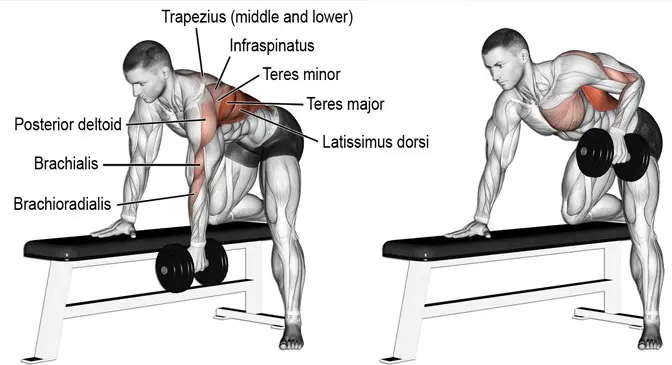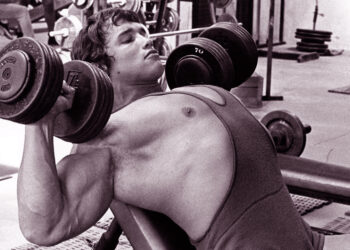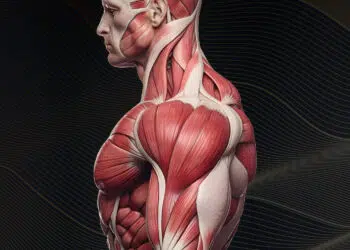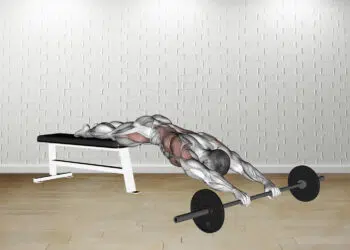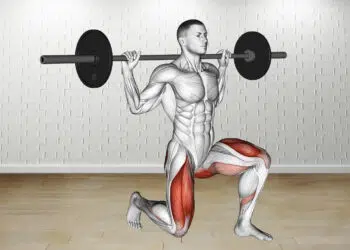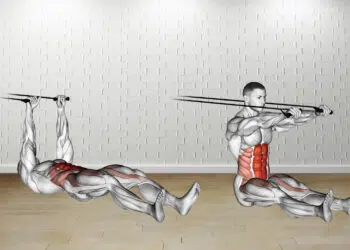As a kid, I really struggled with thoracic kyphosis (rounded upper back). My anterior abdominal musculature was so much stronger than my back muscles, such as traps, lats, and rhomboids.
That’s why I started performing multiple row exercise variations on a weekly basis, so I can “teach” my shoulder blades and surrounding muscles how to hold my posture properly, preventing excessive rounding.
The bent-over dumbbell row was, and still is my favorite back exercise.
In fact, a study titled “Comparison of different rowing exercises” compared trunk muscle activation and lumbar spine motion, load, and stiffness across three rowing variations, including inverted rows, standing bent-over rows, and cable rows.
The study found that bent-over rows elicited the most significant activation of back muscles. (1)
As a Faculty of Sport and Physical Education student, I have prepared an easy-to-follow guide on how to perform the bent-over dumbbell row correctly without any form and technique mistakes.
Level Up Your Fitness: Join our 💪 strong community in Fitness Volt Newsletter. Get daily inspiration, expert-backed workouts, nutrition tips, the latest in strength sports, and the support you need to reach your goals. Subscribe for free!
In addition to that, you will also learn the benefits of this exercise, the muscles worked, and the best variations and alternatives to include in your back/pull workouts.
Perform a Bent-Over Dumbbell Row Step-By-Step Guide
Below is a simple, step-by-step guide on how to perform a bent-over dumbbell row without any mistakes so you avoid back injuries.
Step One — Assume the Starting Position
Pick two dumbbells of appropriate weight. Assume the standing starting position with your feet hip-width apart. Slightly flex your knees and keep them in the same position throughout the entire exercise.
Bend forward in your hips and aim to become as parallel to the floor as possible. Let the dumbbells hang from your hands. Keep your back neutral by contracting your abdominal muscles to provide sufficient support for your lumbar spine.
Pro Tip: Protract your shoulder blades fully (move them away from the middle of your body) so you can achieve a greater range of motion throughout the entire exercise. Exercising the muscles surrounding your shoulder blades (scapula) is crucial, so you teach your back muscles how to hold proper posture on a daily basis.
Step Two — Row the Dumbbells
There are two rowing trajectories to choose from:
First, row towards your hip area or a little lower to activate your lats more. Second, row towards the middle of your stomach to activate your traps and rhomboids more.
Either is good, but you should find the sweet spot between these two positions if you are a total beginner. When the dumbbell is at the level of your body, hold that position for one second.
Pro Tip: Squeeze your shoulder blades at the end range of motion for better activation of upper back muscles. Bring them towards the center of your spine.
Step Three — Return to the Starting Position
Return the dumbbell to the starting hanging position by flexing your shoulders and extending the elbows. Control this descending/eccentric phase of the lift to allow for more time under tension. When you extend your elbow fully, add the additional movement with your scapula to lower your arm further.
This is shoulder blade protraction, where you move your shoulder blades away from the center of your body (spine).
Pro Tip: Engage your core and glutes so you can stabilize the movement better and “isolate” the exercise more. This will prevent many injuries while also allowing you to execute bent-over dumbbell rows seamlessly with the perfect form and technique.
Muscles Targeted
The primary muscles targeted during bent-over dumbbell rows are:
- Latissimus dorsi
- Rhomboids and trapezius (upper and middle back)
- Rear deltoids (back of shoulders)
The secondary muscles working are:
- Biceps brachii
- Forearm muscles
- Erector spinae (lower back)
- Core muscles (abs and obliques)
Benefits
The benefits of bent-over dumbbell rows include enhanced upper body strength, improved posture, balanced muscle development, increased core stability, versatility, and adaptability.
Let’s touch on each of these briefly.
Enhanced Upper Body Strength
Bent-over dumbbell rows will effectively build your upper back muscles, such as traps, lats, rhomboids, and posterior deltoids. Not only that, but this exercise will activate all your back muscles to a certain extent, which is desirable in these dark modern times of sedentary lifestyles.
Rows, in general, are so useful for developing your pulling strength. And in today’s day and age, where more and more people experience rounded back and caved shoulders, this is invaluable.
Improved Posture
Rows are one of the best strength exercises for improving your overall posture. Bent-over dumbbell rows work the muscles around your shoulder blades and your core musculature to stabilize the movement.
The core and the muscles around your shoulder blades are essential for keeping your posture healthy, and that’s why you should implement rowing variations in your weekly workout schedule whenever you can.
Level Up Your Fitness: Join our 💪 strong community in Fitness Volt Newsletter. Get daily inspiration, expert-backed workouts, nutrition tips, the latest in strength sports, and the support you need to reach your goals. Subscribe for free!
Balanced Muscle Development
One of the studies found on the National Center for Biotechnology Information website, titled “UPPER BODY PUSH AND PULL STRENGTH RATIO IN RECREATIONALLY ACTIVE ADULTS,” suggests that the upper body “pushing” musculature is approximately 1.5–2.7 times stronger than the musculature involved for pulling. (2)
This is why we must start implementing pulling exercise more into our workouts. The imbalance coming from our pushing and pulling muscles causes bad posture, lower back pain, and compensatory movements. A single weekly session that includes some form of vertical and horizontal pulling can compensate for this negative effect drastically.
Increased Core Stability
Dumbbells are free weights, and free weights challenge our stability. Performing bent-over dumbbell rows will drastically improve the strength and functionality of our core musculature, which is priceless. It isn’t a secret that solid core muscles prevent injuries and protect our lumbar spine from being exploited.
Versatility and Adaptability
There are many ways you can row a dumbbell towards your body. Also, each time you row differently, your body will adapt in a certain way. This is also important because forming new movement patterns inside our central nervous system (CNS) is highly beneficial for our motor skills, such as coordination.
Not only that but whenever you learn a new movement, new synapses are created between your neurons. Essentially, we can’t increase our number of neurons. But we can form an almost infinite number of synapses between already existing ones.
Variations and Alternatives
The best bent-over dumbbell row variations and alternatives include single-arm dumbbell rows, barbell bent-over rows, and seated cable rows.
Let’s cover each one briefly.
Single-Arm Dumbbell Row
Single-arm dumbbell rows are one of the best unilateral pulling exercises for strengthening your upper body. Not only that, but unilateral exercises, in general, are heavily used in physical therapy to correct muscle imbalances.
They are also more functional because of their asymmetry and because we rarely perform bilateral movements in real-life scenarios.
Steps:
- Pick the appropriate dumbbell and hold it in the right hand.
- Assume a split stance with your right foot backward in front of the bench or plyo box.
- Place your left hand on the bench in front of you as a support.
- Push your hips towards the ceiling and make your body as parallel to the floor as possible.
- Row the dumbbell towards your right hip.
- When the dumbbell reaches the level of your hip, hold that position for one second.
- Reverse the motion by returning the dumbbell to the starting position.
- Repeat for the desired amount of reps.
Pro Tip: Slowly lower the dumbbell towards the floor so you allow for better strength and hypertrophy effects. Also, performing slower eccentrics teaches your body how to absorb the force properly, and that is highly useful for lowering the chance of injuries.
Barbell Bent-Over Row
The barbell bent-over row is a staple back exercise used heavily for building foundational horizontal pulling strength.
Steps:
- Place the barbell on the floor and load it with proper weight plates.
- Assume a standing position in front of the barbell with your feet between hip and shoulder-width apart.
- Bend down, take the overhand grip around shoulder-width apart, and lift the barbell to the standing position.
- Bend forward in your hips so your body is almost parallel to the floor while keeping your knees slightly flexed throughout the entire exercise. This is your starting position.
- Start the exercise by rowing the barbell towards your hips.
- When the barbell reaches the level of your hips, hold that position for one second.
- Reverse the motion to return the barbel to the starting position.
- Repeat for the desired amount of reps.
Pro Tip: Squeeze your shoulder blades at the end range of motion to further activate the muscles responsible for keeping your thoracic posture healthy.
Seated Cable Row
Seated cable rows are excellent for both strength and muscle hypertrophy of your back muscles. Usually, I include them as the second or third exercise in my back workout sessions because machine-based exercises require less energy, stability, and central nervous system (CNS) activation.
Steps:
- Load the cable machine with the appropriate weight.
- Sit on the machine and slightly flex your knees. Make sure to keep them in the same position during the entire exercise.
- Grab the cable attachment and pull it until your body is in the neutral sitting position.
- Start the exercise by pulling the attachment towards your stomach/hips.
- At the end range of motion, hold the position for one second of isometric contraction.
- Reverse the motion to return the attachment to the starting position.
- Repeat for the desired amount of reps.
Pro Tip: Contract your core muscles to fixate your lower back so you can isolate the back muscles more for better hypertrophy effects.
FAQs
Can you go heavy with bent-over rows?
Absolutely. Otherwise, how are you going to achieve muscle hypertrophy? If you are worried about overloading your lower back, then you should learn how to activate your core muscles better to lower the entire stress on your back. Abdominal breathing also helps with reps, but nothing substitutes a strong core in the end.
You can still achieve strength and hypertrophy with a seated cable version of the exercise. However, the strength you build on the machine is entirely different from the one where you are in an athletic position with free weights challenging your entire being while moving.
The second scenario builds functional strength, and that’s why athletes almost always use free weights instead of machines, except when they are injured. Still, the exception doesn’t disprove the rule.
Should dumbbell rows be fast or slow?
It depends on your fitness goal. If you want to build explosive strength (power), then you should perform every rep as fast as you can. But you can only perform 3-5 such reps, sometimes even 1, depending on your chosen weight.
On the contrary, if you aim to build endurance or hypertrophy, controlled reps with more time under tension and emphasis on muscle contraction will likely be a better option. In the end, it all depends on your goals.
Do dumbbell rows build back thickness?
Yes, dumbbell rows will definitely build a thick back. Bodybuilders always speak about this and recommend just about any kind of row for developing a thicker back. However, if you aim to build a wide back, then performing any form of vertical pull exercise might be a better choice. Think in terms of pull-ups, lat pulldowns, dumbbell pullovers, and similar exercises.
Wrapping Up
Dumbbell bent-over rows are a fantastic exercise for developing strong and functional back muscles. They are excellent at balancing out your muscle development, increasing your core stability, and improving your overall posture. You should include dumbbell bent-over rows in your regular pull workout sessions as much as you can.
This is because it will build functional strength, something you need in your daily life and not just for the sake of looking big and strong. In the comments below, let me know how you implement bent-over dumbbell rows and whether you experience any form or technique problems.
References:
- Fenwick CM, Brown SH, McGill SM. Comparison of different rowing exercises: trunk muscle activation and lumbar spine motion, load, and stiffness. J Strength Cond Res. 2009;23(2):350-358. doi:10.1519/JSC.0b013e3181942019
- Negrete RJ, Hanney WJ, Pabian P, Kolber MJ. Upper body push and pull strength ratio in recreationally active adults. Int J Sports Phys Ther. 2013;8(2):138-144.
Relevant Articles:
Interested in measuring your progress? Check out our strength standards for Dumbbell Pullover, Upright Row, Pull Ups, and more.

